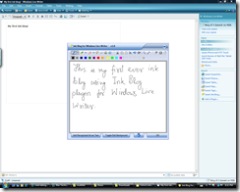I never thought that anybody will ever write such a post! And I would have considered myself to be the last person to ever think of making the switch.
But it happened. I have been using Windows Vista Home Basic on my HCL MiLeap-L, which originally came loaded with Ubuntu 7.10 which I had upgraded to Ubuntu 8.04 very recently. The switch was not a single day decision. I was using Ubuntu on my MiLeap of quite a time, in fact ever since I purchased it, thats about six months ago. Over the time I realised that I was spending more and more time configuring and fine tuning the Ubuntu installation than actually getting any real work done. True, I learned (majority of the times re-learned) many a things, but I just felt that all this was a complete waste of time. The Ububtu updates are one of the most horrid experiences; they can come any time (unlike scheduled release of Windows updates) and they are big all the time (10s or 100s or MBs!). Then as I mentioned in this post, that I had to recompile the rt73 drivers for appropriately supporting wi-fi ad-hoc mode... this resulted in another pain, every time there is a kernel version change, I had to recompile these drivers. And after I updated to Ubuntu 8.04 there have been at least a dozen of these updates. All this made me think hard and finally I switched over to Vista.
I have installed a Windows Vista Home Basic edition on MiLeap, as this is the only edition which is fit for the kind of hardware that is there on my laptop. I chose Vista instead of XP because I have been using Vista on primary desktop and my experience with it has been a far better environment than XP.
It took about 2hrs to completely install Vista and get the desktop. The drivers for my Wi-Fi and Sound were missing in the default install. Which were easy to obtain from Windows update ( I connected to the net using the Ethernet port on my laptop). I also quickly updated to SP1. Overall the amount of download was about 300 MB. This was far better than Ubuntu, where I am sure that I have done more than 2GB updates.
So what do I miss from Ubuntu world?
If I forget about the philosophical reason for using Ubuntu, which anyway a user hardly cares (a user psychology is always to get her task done, and very rarely how the task is done)... I only miss one thing: the gcc compiler package. That said, I rarely used it on my laptop, as most of the time I accessed it from either my VirtualBox installation or my old and well configured FC6 linux box. There was obviously no problem in installing Python and Java on my laptop, that I frequently use (need)...Python for trying out s/t quickly and Java ofcourse for MeTA Studio :)
Other things that I generally use on my laptop: OpenOffice, LaTeX, Media player and Browser are there in Vista. OpenOffice and LaTeX of course had to be installed. But the Windows Media player and IE7 are just great. I hardly used Firefox in Ubuntu (when I had it installed), but rather used Opera as it was better and faster. But on Vista I am sticking to IE7 for the time being, for some strange reasons like this and this [links to previous post].
The new Windows media player has a simple but amazing feature, that allows you to share your playlist to other Windows media player capable devices.. and you can guess what I do with my desktop and laptop ;)
Next, I used to use Gizmo to make voice calls to my GTalk mates... now with GTalk available natively, I am evidently not missing it.
Next, my laptop has a strange screen resolution: 800x480. Ubuntu had always trouble with this, most of the dialogs never fitted properly in the display area, even after I did a lot of tweaking. Vista was not without problems though. The first time I started it, it went to a virtual 1024x768 resolution and gave me a scrollable desktop! But after I changed the resolution appropriately, all most all the dialogs I have encountered are fitted properly in the display area... which is sorta great considering that Vista was never made for such a low powered ULCPCs.
Boot up time of Vista is about same as Ubuntu, provided AVG is not installed. In any case I installed and uninstalled AVG which I found to really slow down my laptop to make it almost unusable. So, for the moment I rely on Vista's "strong" security features and windows defender to protect me against malicious attacks.
Though battery times are almost equal for both Vista and Ubuntu, I find Vista does a better job in handling the "sleep" mode. For me the sleep and the hibernate feature never worked on the Ubuntu setup. But it has worked out-of-box for the Vista installation. And now, I never shutdown my laptop ... I just put it to sleep :-) Putting it in sleep mode has obvious advantage of getting the desktop back in under 20sec (max), as against about 2mins required to boot up the whole stuff. My desktop though boots in less than 20 secs, and wakes up from a sleep in about 5 secs ... owing obviously to quite high end hardware specs.
So whats not well with Vista?
Well the general answer to this Q is, nothing so far ;)
But there are a few things that are not smooth. One of the prime things is the support for Bluetooth dongles. While on Linux I found that most of the dongles work properly without a hassle, this is not true with Vista, forget about earlier versions of Windows. I simply do not understand why this area is so neglected in Windows.
In Ubuntu, when running on battery mode, the GNOME applet always used to display the amount of time the battery will last. But in Vista so far what I get the the % amount of battery remaining, this to me is actually not so helpful. Till now I have not found a way to change this.
And what about Vista ratings?
aka. Windows Experience Index. Here is it:
evidently, the very basic stuff, if you compare it with my dekstop:
PS: This post was written on my MiLeap running on Vista Home Basic using Windows Live Writer.
PPS: I am in no way advocating the use of Vista. I am just telling my experience. Its for each user to decide what is best for him/her. I am no way related to Microsoft and this post is not endrosed by them either.





















.jpg)






